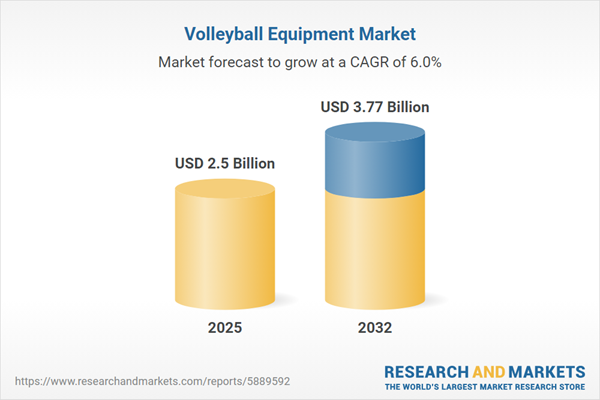Speak directly to the analyst to clarify any post sales queries you may have.
The volleyball equipment market is evolving rapidly, driven by rising global participation, advancing product technologies, and a growing focus on sustainable manufacturing. Senior stakeholders seeking to navigate this dynamic arena require actionable insights into market drivers, segment growth, and strategic imperatives for competitive advantage.
Market Snapshot: Growth and Industry Performance
The volleyball equipment market grew from USD 2.37 billion in 2024 to USD 2.50 billion in 2025. It is expected to continue growing at a CAGR of 5.96%, reaching USD 3.77 billion by 2032. This robust expansion reflects heightened consumer interest, investments in product innovation, and shifting competitive dynamics as brands diversify their portfolios across both indoor and outdoor segments. The sustained pace of development confirms volleyball equipment’s resilience in a changing global sports landscape, making it a focus for strategic investment.
Scope & Segmentation of the Volleyball Equipment Market
- Product Types: Accessories, apparel, balls, equipment, and footwear drive market activity, each responding to specific athlete and institutional needs.
- Types: Indoor and outdoor volleyball remain distinct in their product demands and serve divergent audiences and venues.
- Materials: Composite, leather, and synthetic constructions shape performance attributes and pricing strategies, impacting user decisions at every level.
- End Users: Amateur, recreational, and professional players exhibit different expectations around durability, compliance, and affordability.
- Distribution Channels: Direct sales, offline retailers, and online retailers serve varied purchasing preferences, from hands-on buying to digital convenience.
- Regions: Americas (United States, Canada, Mexico, Brazil, Argentina, Chile, Colombia, Peru), Europe, Middle East & Africa (including United Kingdom, Germany, France, Russia, Italy, Spain, Netherlands, Sweden, Poland, Switzerland, United Arab Emirates, Saudi Arabia, Qatar, Turkey, Israel, South Africa, Nigeria, Egypt, Kenya), and Asia-Pacific (China, India, Japan, Australia, South Korea, Indonesia, Thailand, Malaysia, Singapore, Taiwan) each feature unique demand drivers shaped by economic, cultural, and institutional factors.
- Key Players: Market analysis covers brands such as AALCO Manufacturing, Adidas AG, Amer Sports Oy, ASICS America Corporation, Baden Sports, Bison Inc., Bodyprox, Carroll Seating Company, Carron Net Company Inc, Carter Crompton, Cobra Volleyball, Douglas Sports, Gared Holdings LLC, Garmy Sports, Gourock Inc, Jaypro Sports LLC, Mikasa Corporation, Mizuno Corporation, Molten Corporation, Nike Inc., Schelde Sports, SNA Sports Group, Spalding Sports Equipment, Under Armour Inc., United Volleyball Supply LLC, VolleyCountry.
Key Takeaways for Decision Makers
- Technology integration, such as sensors in balls and connected wearables, is transforming equipment functionality and athlete performance tracking.
- Brands pursuing omnichannel distribution and digital engagement are better able to meet the evolving preferences of both teams and individual consumers.
- Materials innovation, including the adoption of advanced composites and sustainable synthetics, is reshaping product design and market positioning.
- Regulatory changes and trade policy shifts are prompting many manufacturers to review sourcing strategies and invest in supply chain resilience.
- Product customization and consumer data are increasingly leveraged to inform rapid product iteration, placing analytics at the forefront of competitive strategy.
- Emergence of region-specific growth patterns necessitates nuanced go-to-market strategies tailored to infrastructure, cultural preferences, and regional demand drivers.
Tariff Impact on Global Supply Chains
The introduction of United States tariffs on imported athletic goods, including volleyball equipment, has led manufacturers to accelerate onshoring efforts, diversify supplier networks, and pursue regional partnerships. These adjustments are intended to soften the effect of compressed margins and increased landed costs. As a result, domestic production expansion and strategic nearshoring have gained momentum, especially among brands seeking to bolster market responsiveness and supply chain control.
Primary Keyword: Volleyball Equipment Market
Research Methodology & Data Sources
This report draws on a hybrid approach combining in-depth interviews with product developers, league officials, and distribution leaders as well as extensive analysis of industry publications, patent filings, and trade data. Triangulation of quantitative findings with qualitative insights ensures comprehensive, credible conclusions for market participants.
Why This Report Matters
- Enables senior leaders to identify actionable growth opportunities and invest confidently in technology and supply chain adaptation.
- Facilitates precise segmentation strategies aligned with changing buyer behaviors, regulatory landscapes, and material advancements.
- Equips organizations to anticipate and manage risks related to tariffs, trade policies, and sustainability requirements in the athletic goods sector.
Conclusion
Informed by rigorous methodology and up-to-date market intelligence, this report delivers strategic clarity for navigating the global volleyball equipment sector. Decision makers are empowered to leverage data-driven insights, align resources, and enhance organizational resilience.
Additional Product Information:
- Purchase of this report includes 1 year online access with quarterly updates.
- This report can be updated on request. Please contact our Customer Experience team using the Ask a Question widget on our website.
Table of Contents
3. Executive Summary
4. Market Overview
7. Cumulative Impact of Artificial Intelligence 2025
Companies Mentioned
The companies profiled in this Volleyball Equipment market report include:- AALCO Manufacturing
- Adidas AG
- Amer Sports Oy
- ASICS America Corporation
- Baden Sports
- Bison, Inc.
- Bodyprox
- Carroll Seating Company
- Carron Net Company, Inc
- Carter Crompton
- Cobra Volleyball
- Douglas Sports
- Gared Holdings LLC
- Garmy Sports
- Gourock Inc
- Jaypro Sports, LLC
- Mikasa Corporation
- Mizuno Corporation
- Molten Corporation
- Nike, Inc.
- Schelde Sports
- SNA Sports Group
- Spalding Sports Equipment
- Under Armour, Inc.
- United Volleyball Supply, LLC
- VolleyCountry
Table Information
| Report Attribute | Details |
|---|---|
| No. of Pages | 189 |
| Published | November 2025 |
| Forecast Period | 2025 - 2032 |
| Estimated Market Value ( USD | $ 2.5 Billion |
| Forecasted Market Value ( USD | $ 3.77 Billion |
| Compound Annual Growth Rate | 5.9% |
| Regions Covered | Global |
| No. of Companies Mentioned | 27 |









